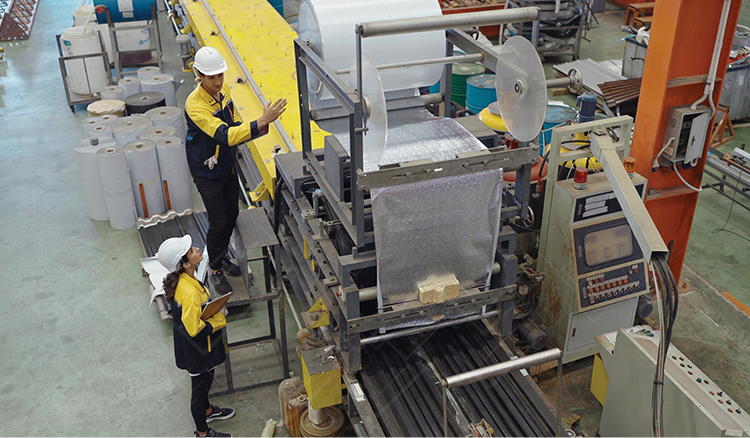How US Manufacturing Can Realize Productivity Growth
US Manufacturing is lagging behind the overall economy in growth, according to the Institute for Supply Management’s Purchasing Managers Index (PMI). The sector is seeing limited growth, however, with a PMI above 60%.
Anything above 50% on the PMI signals growth, so the high score in December shows growth as the effects of reshoring pick up speed and manufacturing shakes off the cobwebs from years of stagnation.
For 2020, the PMI shows continual growth since the dip in March when the pandemic hit businesses. An increase in new orders and production continued in December. If this trend keeps up as the pandemic is addressed, there will be a significant need to do things differently so the manufacturing sector can keep up with the increasing demands of consumers.
According to the Wall Street Journal, 2020 marked the end of a long decline for US manufacturing as reshoring and technological advancements make manufacturing environments more efficient, data-rich, and better places to work than ever before.
With the stars aligning, we believe it’s time for manufacturing to accelerate growth even more in 2021 and beyond. It is high time to revitalize US manufacturing and realize the productivity growth that will bring the industry back in line with its former contribution to the overall GDP of the country.
Why multifactor productivity is the current key to growth
To deliver these levels of projected growth, manufacturers will have to find a way to increase multifactor productivity, a measure of economic performance that compares the amount of output to the amount of combined inputs used to produce that output.
In the classic Cobb-Douglas production function, we have three options for increasing gross domestic productivity: multifactor productivity, capital input, and labor supply.
Capital input as a growth agent
Capital input, such as additional assets and investment funding, are likely to remain constant as manufacturing stays steady. This is not likely to be a huge source of growth for the manufacturing industry overall, outside of computing technology, which according to a paper from the Brookings Institute was the source of all manufacturing growth between the years 2000 and 2011. For this reason, investors might be bearish on the rest of manufacturing and bullish on computer-related manufacturing.
Labor supply as a growth agent
Due to the pandemic in 2020, the supply of labor has been disrupted because of mass layoffs across industries, leaving many people out of work until they settle into a new role. This might mean moves from one industry to another, creating a great opportunity for new laborers to settle into manufacturing, while conversely increasing the chances that workers in manufacturing might fill the gaps left by displaced workers in other industries. This makes the labor supply a less powerful lever for increasing the GDP of manufacturing.
Multifactor productivity as a growth agent
The real source of efficiency improvements come in how the labor is deployed, much more so than in the available supply of labor. This type of innovation would fall under multifactor productivity, the third lever we can pull to increase GDP.
A slow growth in the population and a decline in participation in the labor force mean there is less available labor to work with. However, if businesses drive up the labor force participation rate through flexible work arrangements with workers who would be disengaged otherwise, they can innovate around the apparent limitations imposed by a limited supply of labor.
The simple way of putting this is that manufacturers will have to do more with what they have to affect productivity in the short-term.
Capacity utilization, a measure of how fully firms are using their resources, is one area that is particularly ripe for change. According to Reuters, “capacity utilization for the manufacturing sector rose 0.6 percentage point to 72.6% in November. Overall capacity use for the industrial sector increased to 73.3% from 73% in October. It is 6.5 percentage points below its 1972-2019 average.”
This shows that there is ground to make up for the manufacturing sector in how effectively it deploys its resources. Businesses need to be more opportunistic as they pursue additional revenue. To do this, they’ll need to do more with less, especially when it comes to building their workforce with the right skills and the right people. By making the most of the technology available to them and finding ways to respond to demand more quickly as it comes, manufacturers can capture the opportunities of increased orders as the pandemic recedes.
How on-demand labor can fuel growth in manufacturing
With the changes in consumer preferences for speed of delivery and customization, demand volatility is at an all time high and will only get worse. The only way to keep up is to respond more quickly and specifically to demands. But to do that, the time-tested methods of planning a headcount based on average demand and massaging orders into a smoothed production schedule simply won’t work.
To more effectively deploy the available labor supply, companies will need to respond to customer demand in real time by bringing in the labor as necessary. Historically this has not been possible, due to the slow response nature of employment and contract models. However, with recent technological advancements and platforms such as Veryable providing labor on-demand, the available labor supply to a company can be as flexible as it needs to be.
This brings cost per unit down by ensuring that the company is only paying for the labor that is needed to fill orders, rather than paying people to inevitably stand around during the slow periods. Conversely, this provides the ability to source additional labor hours without incurring overtime.
Because there are workers not currently in the workforce who would be working if given a source for such flexible arrangements, a latent supply of labor exists that is virtually untapped. With on-demand labor, we can unlock this potential by creating a mutually beneficial arrangement between manufacturing companies and independent workers.
So without the need for additional capital input or a large boost to the overall labor supply available to manufacturing, there can be massive productivity gains through the more efficient deployment of existing labor and by enabling workforce participation for workers who do not want traditional employment.
Previous Posts
How Policy Constraints, Not Just Production Bottlenecks, Threaten Your Bottom Line
The Future of Manufacturing and Logistics
Create a free business profile today to explore our platform.






